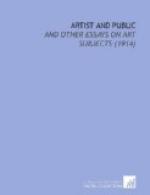[Illustration: Plate 22.—Titian. “St. Jerome in the Desert.” In the Brera Gallery, Milan.]
Now, it is evident that there is not nearly so much literal truth to the appearance of nature in this picture as in Sargent’s. It is not only that it would never have occurred to Titian to try to paint the glittering spottiness of sunlight splashing through leafage, or to attempt to raise his key of light to something like that of nature, at the cost of fulness of color. It is not merely that he translates and simplifies and neglects certain truths that the world had not yet learned to see. He deliberately and intentionally falsifies. He knew as well as we do that a natural landscape would not arrange itself in such lines and masses for the purpose of throwing out the figure and of enhancing its emotion. But to him natural facts were but so much material, to be treated as he pleased for the carrying out of his purpose. He was a colorist and a chiaroscurist; and he had a great deal more interest in light and in landscape than most of the painters of his time. If he had been pre-eminently a draughtsman, like Michelangelo, he would have reduced his light and shade to the amount strictly necessary to give that powerful modelling of the figure which is the draughtsman’s means of expression, would have greatly increased the relative size and importance of the figure, and would have reduced the landscape to a barely intelligible symbol. Had he been a linealist, like Botticelli, he would have eliminated modelling almost altogether, would have concentrated his attention upon the edges of things, and would have reduced his picture to a flat pattern in which the beauty and expressiveness of the lines should be almost the only attraction.




